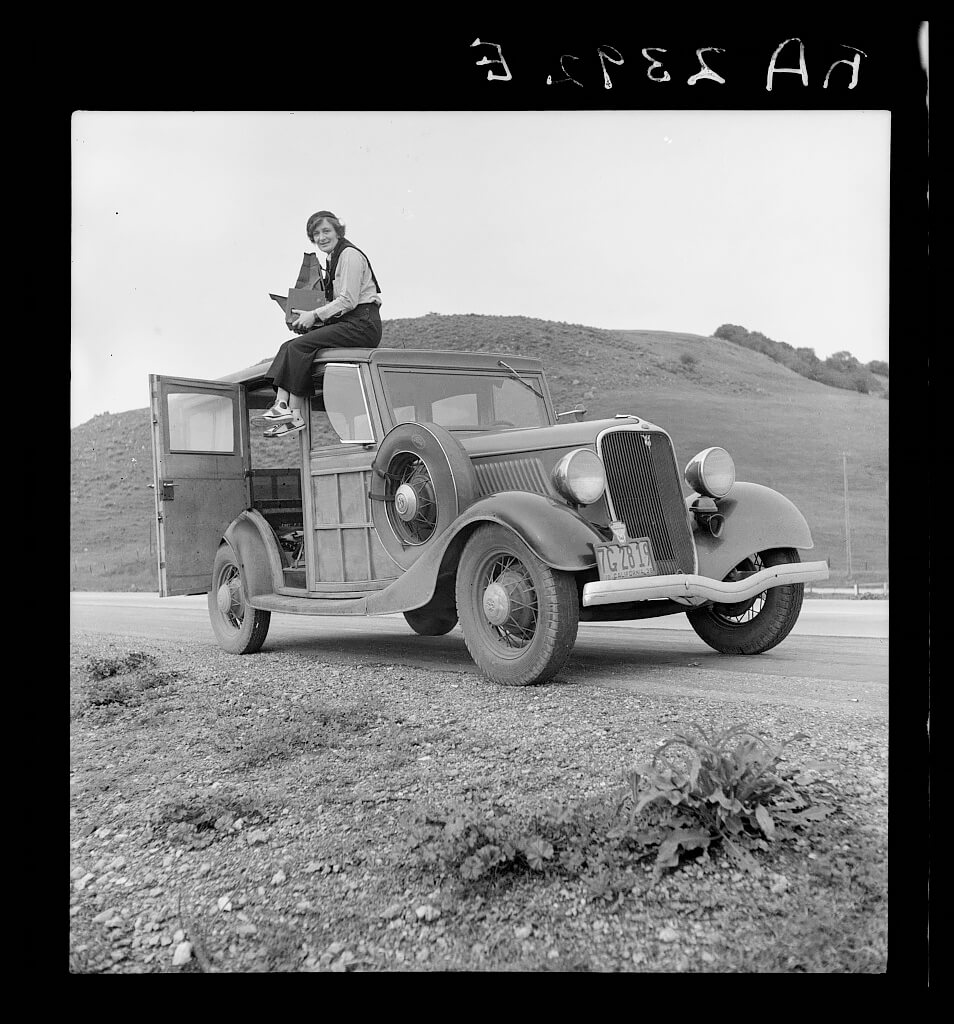Dorothea Lange was an American documentary photographer, who studied photography at Columbia University and worked as an assistant to
Arnold Genthe before beginning a photographic trip around the world in 1918. When she ran out of funds in San Francisco, she remained, opened a photographic studio, and during the early 1930s began photographing homeless rural people flooding into the city from the
Dust Bowl exodus.
Her photographs brought her to the attention of
Paul Taylor, an economist at California University, who hired her to create a documentary record to accompany his report on agricultural conditions for the
California State Relief Administration, and subsequently married her.
When
Roy Stryker saw these images, he hired her as a staff photographer for the
Farm Security Administration (FSA), for which she worked sporadically as Stryker's budget allowed 1935-9. During this period, she made many of her best-known photographs, including the image known as
Migrant Mother (1936). She later also photographed for the San Francisco branch of the
Office of War Information, 1943-5, recording the internment of Japanese-Americans and the founding of the United Nations.
In 1954-5 she was a photographer for
Life magazine, afterward travelling extensively and producing photographic essays on Ireland, Egypt, and Asia.
Source: The Oxford Companion to the Photograph
In 1945,
Ansel Adams invited Lange to teach at the first fine art photography department at the
California School of Fine Arts (CSFA), now known as
San Francisco Art Institute (SFAI).
Imogen Cunningham and
Minor White also joined the faculty.
In 1952, Lange co-founded the photography magazine
Aperture. In the mid-1950s,
Life magazine commissioned Lange and
Pirkle Jones to shoot a documentary about the death of the town of Monticello, California, and the subsequent displacement of its residents by the damming of Putah Creek to form Lake Berryessa. After Life decided not run the piece, Lange devoted an entire issue of
Aperture to the work. The collection was shown at the
Art Institute of Chicago in 1960.
Another series for
Life, begun in 1954 and featuring the attorney
Martin Pulich, grew out of Lange's interest in how poor people were defended in the court system, which by one account, grew out of personal experience associated with her brother's arrest and trial.
Lange's health declined in the last decade of her life. Among other ailments she suffered from was what later was identified as post-polio syndrome. She died of esophageal cancer on October 11, 1965, in San Francisco, at age seventy. She was survived by her second husband, Paul Taylor, two children, three stepchildren, and numerous grandchildren and great-grandchildren.
Three months after her death, the
Museum of Modern Art in New York City mounted a retrospective of her work that Lange had helped to curate. It was
MoMA's first retrospective solo exhibition of the works of a female photographer. In February 2020,
MoMA exhibited her work again, with the title
Dorothea Lange: Words and Pictures, prompting critic Jackson Arn to write that "the first thing" this exhibition "needs to do—and does quite well—is free her from the history textbooks where she’s long been jailed." Contrasting her work with that of other twentieth-century photographers such as Eugène Atget and André Kertész whose images "were in some sense context-proof, Lange’s images tend to cry out for further information. Their aesthetic power is obviously bound up in the historical importance of their subjects, and usually that historical importance has had to be communicated through words." That characteristic has caused "art purists" and "political purists" alike to criticize Lange's work, which Arn argues is unfair: "The relationship between image and story," Arn notes, was often altered by Lange's employers as well as by government forces when her work did not suit their commercial purposes or undermined their political purposes. In his review of this exhibition, critic Brian Wallis also stressed the distortions in the "afterlife of photographs" that often went contrary to Lange's intentions. Finally, Jackson Arn situates Lange's work alongside other Depression-era artists such as Pearl Buck, Margaret Mitchell, Thornton Wilder, John Steinbeck, Frank Capra, Thomas Hart Benton, and Grant Wood in terms of their role creating a sense of the national "We".
In 2003, Lange was inducted into the National Women's Hall of Fame. In 2006, an elementary school was named in her honor in Nipomo, California, near the site where she had photographed Migrant Mother. In 2008, she was inducted into the California Hall of Fame, located at The California Museum for History, Women and the Arts. Her son, Daniel Dixon, accepted the honor in her place. In October 2018, Lange's hometown of Hoboken, New Jersey honored her with a mural depicting Lange and two other prominent women from Hoboken's history, Maria Pepe and Dorothy McNeil. In 2019, Rafael Blanco (artist) painted a mural of Lange outside of a photography building in Roseville, California.

